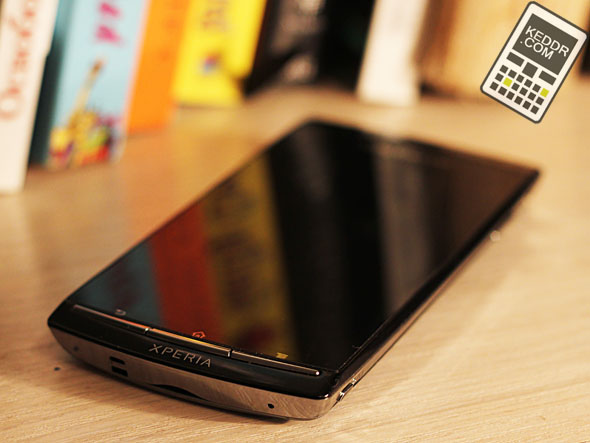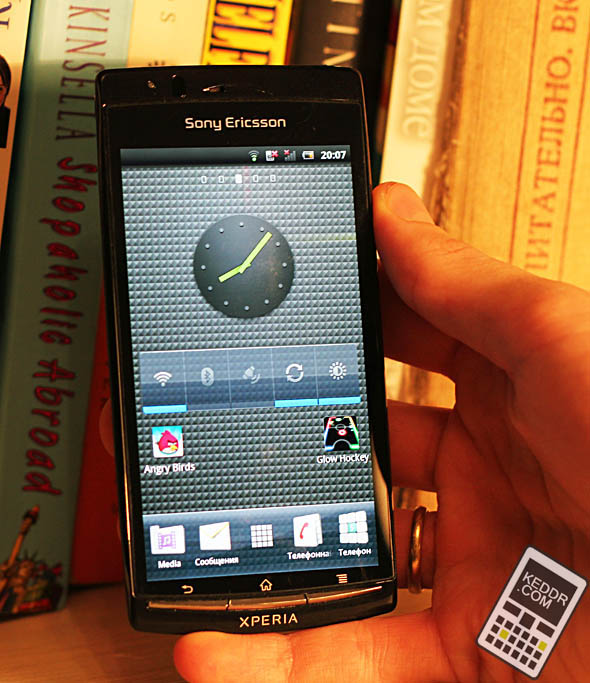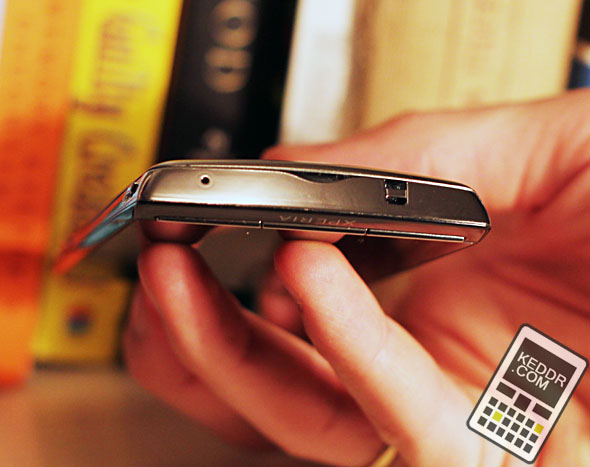Sony Ericsson XPERIA arc. The thinnest Android in the world

Looking at the new model from Sony Ericsson, you can be truly happy for the company. They not only released yet another smartphone in the XPERIA line, but, retaining their familiar recognition, showed us something unique.
The XPERIA arc model was introduced to the world quite recently, just a few weeks ago. And now we will rejoice for two more facts. The smartphone fell into our hands less than a month after the announcement. This is really good, because, very often, a smartphone has to wait until the start of sales. And the second point - in arc pre-installed Android OS version 2.3! Bravo, Sony Ericsson! We hope this moment will be a turning point and there will be no more delays in updating the software. By the way, most of the smartphones presented at CES 2011 were running Android 2.2, so arc really made a difference!
Appearance and body
Before us is the thinnest smartphone of today. Case thickness is only 8.7 mm. But we know that in just a few weeks the world will see the second generation of Samsung Galaxy S, so that the palm of the hand at the “arch” may be taken away even before the start of sales. But the style will not change from this, and the device has a lot of it. Appearance is really remembered and impresses.
A slightly unusual case shape catches your eye - its back side is concave inward. If you put the phone on a flat surface, you get such an arch. “Why would it be?” That makes sense. This is not just a bend, but Human curvature technology developed by the company. Thanks to this form, the smartphone repeats the surface of the palm and lies comfortably in it.
In general, I noticed that manufacturers began to experiment a lot, in particular with bends. Remember only about the Nexus the S . I think this is good, since the market in general will not be gray and square, but diverse and interesting.
The entire Arc body is made of plastic and, moreover, glossy. Of course, “whoever says” - you say, and you will be right. But even in the Nexus S, I have never praised the use of glossy plastic. As expected, it is easily soiled, fingerprints and stains remain and are clearly visible. Like a small compensation - mineral glass display, which gives rise to a sense of reliability.
Speaking of the case as a whole. In the hand, the phone feels on the verge of convenience and already discomfort. But, while on the side of convenience. The fact is that the smartphone is big enough, add a little more to it and you get a “shovel” in the palm of your hand. Thickness is not given in any way, it is convenient to hold a smartphone. But, due to the fact that the body is completely plastic, there is a feeling of slight deformation during torsion. I relate to smartphones very carefully, almost everything that I had avoided was avoided. Of course, I don’t carry phones in my back pocket, because you can forget and sit on a stump. So, if you tend to carry in the back pocket - urgently wean, the “arch” may not be able to support the weight of your body in case of an unsuccessful fit.

The chrome edging that runs through the entire apparatus, also plastic, is simply painted “chrome”. It’s not yet possible to understand how this coating will behave, but the sharp chrome-plated corners alarm me.
But the location of all the elements really cool fits into the design. Function buttons, sensors and speaker, other elements - everything is not just stuck, but placed so that it looks aesthetically pleasing.
Arrangement of elements
The front side is almost completely occupied by the display, with a diagonal of 4.2 "and a resolution of 480x854 pixels. Of course, Sony Ericsson could not call the display a display, otherwise the battle on the market would be lost. Gentlemen, here is the Reality Display using Mobile Bravia technology Engine: I didn’t notice any special differences in color reproduction, contrast, viewing angles compared to the Motorola Milestone screen. The screen is good. It is not as bright as SuperAMOLED, but the picture looks more natural on it. It is worth noting that XPERIA arc has almost no air the gap between the screen and glass, so it seems that the picture is literally on the fingers.
Under the screen there are three function keys. If before arc you already had a smartphone on Android from SE, you have to re-get used to it a bit, the layout of the keys has changed and now the return button is on the left. And if you have never used SE smartphones, then you will have to get used to it twice, because there are only three keys, not four, as is customary for this OS.
The keys themselves, although narrow, but quite comfortable. But their location is one hundred percent tribute to fashion, since the keys almost go to the bottom. You get used to it quickly, but you should be careful, because by reaching for the button you can drop the device.
Unfortunately, there is no front camera. Instead, proximity and light sensors. The last element of the front side is the speaker.

On the left side is a headphone jack. Stop! And what is he doing on the left side? I have headphones with a plug without a bend (this is not so, but let's imagine for an experiment). How will I put the phone in my pocket with the headphones connected, and then in a hurry to get it when a call comes in? I wouldn’t find fault if I hadn’t watched the HDMI connector from above. Will you use this connector when the phone is in your pocket? Unlikely. I think it would be more logical to swap these two elements.

On the right we see the MicroUSB connector, a paired volume key and a camera button. Honestly, the first time I got the phone out of the box while driving, it was in the evening. I tried to find the power key / unlock and groped, but in the end, it turned out to be a volume rocker. If you look not from the point of view of aesthetics, but through the eyes of a practitioner, then the size of the entire rocker is normal for a single button, but not for a paired one. It is extremely uncomfortable to read books when turning over pages with this manipulator. What can I say, finding a key during a call is hard!
With the camera button, the same situation, but it saves the fact that it is. Indeed, many manufacturers simply forgot (and) whether about it. But its size, they are extremely small. Yes, and the button is located very close to the bottom.

At the top we see the HDMI connector, which was already mentioned, and the on / lock button on the screen. The connector is covered with a plug and this is true. But the power key is no more convenient for the rest. It is quite heavily recessed and too small. But you can get used to anything!

The lower part is almost empty. There is a microphone hole and a loop for a lace.

Behind the company logo, a speaker, a second microphone and a camera with flash. Speaking about the latter, the camera in XPERIA arc is probably the strongest side. Not only in comparison with other smartphone functionality, but also among cameras in the phone market in general. The module has a resolution of 8 MP. This is not the biggest figure for today, but the smartphone’s pictures are impressive. However, like the video. Shooting takes place in a resolution of 720p, and the video is beautiful even in the dark. (There is an example in the video review).

The back cover can be removed quite easily. Due to the small thickness of the device, the cover is also very thin and bends strongly in the hands. Under it, we see a battery with a capacity of 1500 mAh, which is enough for 1-2 days of work, a slot for a memory card and a SIM card.

BY
As I already noted, the positive point is the latest version of Android in XPERIA arc. However, there is not much left of the "bare" Android 2.3 here, everything is wrapped in a shell from Sony Ericsson. In many ways, I noticed positive aspects, but I did not like the icons. Most correct, in my opinion, they can be described as not modern.
The shell has its own widgets, many effects. The menu is divided into screens that scroll horizontally. Conveniently, applications can be sorted, sorted, and arranged as you like.
Specifications
The smartphone can not be called the most technologically advanced and productive today. However, to face the truth, Tegra 2 is not very far from powerful single-core processors with video accelerators. XPERIA arc in performance can compete with the Samsung Galaxy S, this is my personal opinion. In some tests, the "arch" even surpasses Galaxy. This suggests that the small thickness did not become to the detriment of the powerful "iron".
The battery capacity is enough for a day of excessive use, and during normal operation - for two.
What upset was the small amount of internal memory, only 314 MB. Yes, there is a slot for MicroSD memory cards, but the problem of lack of space for installed software will sooner or later become an edge. Indeed, even when installed on a memory card, part of the internal space is used.
Standards of GSM 850/900/1800/1900 / UMTS 900/2100, (GPRS / EDGE , HSDPA)
Operating System Android 2.3
Processor Qualcomm MSM 8255, 1 GHz
Graphics Processing Unit Adreno 205
Memory ROM 314 MB, RAM 512 MB
screen Reality Display, 4, 2 "(854 × 480), touch, capacitive
Interfaces USB 2.0 (microUSB), Bluetooth 2.1 + EDR (A2DP), Wi-Fi 802.11 b / g / n
Built-in 8 MP camera , autofocus, widescreen shooting, flash, geotagging
Battery, Li-Ion autonomy , 1500 mAh, 1-2 days
Additional GPS features (maps preinstalled), MS Exchange, synchronization with Google services
Conclusion
Sony Ericsson XPERIA arc is not just another beautiful phone, its appearance is really unique. But, the image did not take away his excitement, the smartphone is quite productive, and is also equipped with an incredibly cool camera. Arc is perfect for everyday use: it is fast, convenient, with sufficient autonomy, and the photo / video camera is often replaced, because the smartphone is always with you.
Android version 2.3, which comes bundled with arc, is one of the main trump cards of the model, along with the camera and thickness. And this gives reason to hope that updates to the latest OS versions on new smartphones of the company will come out more regularly.
